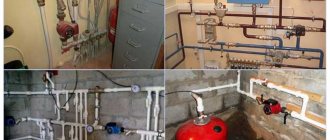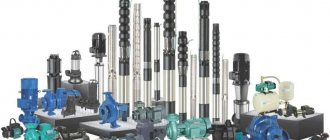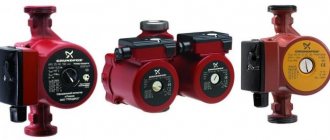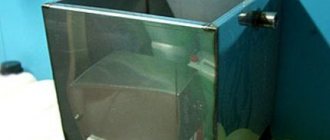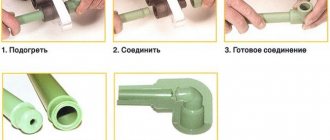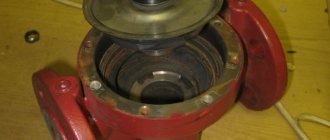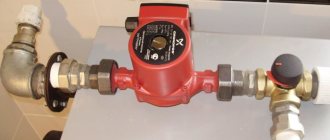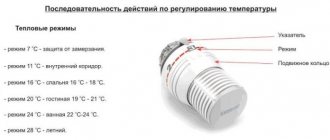Typically, in private homes, heating circuits are installed with forced movement of hot water through pipes. Therefore, when designing communications, you have to calculate the circulation pump for the heating system using a special-purpose calculator or using formulas in order to accurately select the supercharger. Let's consider the design and operating principle of such a device. Read to the end and learn its main varieties, features of application and calculation of basic parameters. We will also tell you about other characteristics and markings.
Example of an installed electric pump Source odstroy.ru
Design features and principle of operation of the electric pump
The coolant circulation pump is a centrifugal device. Its design consists of the following main parts:
- durable body;
- a rotor necessary to transmit torque from the motor shaft to the turbine unit;
- a turbine impeller with inclined blades is the impeller of an electric circulation pump;
- sealing means that provide insulation to prevent water from penetrating electrical and other parts of the pumping device;
- the main electrical circuit, through which the speed of the electric pump is switched and the operation of its electric motor is monitored.
The execution of a certain model affects the design of the circulation pump for heating. It can have a body of different shapes, which determines how the inlet and outlet pipes are located. This feature is taken into account when choosing. Otherwise, it will be difficult or even impossible to install a specific device, since it may not fit the shape of the installation location.
Electric pump with two pipes Source onlinetrade.ru
The pump for circulating the coolant is small in size. Due to its small dimensions, it is often installed inside the housing of a domestic gas heating boiler. Security devices are often placed along with it.
The purpose of the circulation heating electric pump directly affected its size. It has small dimensions because it does not need to pump record pressure into the system. Because of this, all such devices are low-power pumps. However, their performance is quite sufficient for use in in-house autonomous heating systems. Moreover, such pumping equipment is required to move the coolant virtually only horizontally.
Important! Each circulation pump for a heating system is used to overcome the hydraulic resistance of the piping circuit. Such a device is a pumping equipment.
If the electric circulation pump is part of an underfloor heating manifold group, then it is required to create a small flow. After all, there are no significant gravitational forces in underfloor heating.
Installed pump in the underfloor heating system Source heating-in-nn.rf
The operating principle of the circulation pump is as follows:
- The inlet pipe of the supercharger receives the coolant flow.
- From the rotor, torque begins to be transmitted to the working turbine wheel after the engine starts.
- The rotating turbine wheel captures the coolant with inclined blades. The heat carrier begins to move towards its edge due to the action of centrifugal force.
- The pressure and speed of the coolant increases the closer it moves to the edge of the turbine wheel.
- A liquid heat carrier is released through the outlet pipe.
On a note! A vacuum occurs in the inlet of the electric pump as the coolant moves towards the edge of the working disk. Because of this, a new portion of the heat transfer medium is captured, which moves further through the system.
During operation, a vacuum is created at the inlet of the circulation pump. Source build-experts.ru
When selecting a circulation pump, you need to pay attention to its parameters. In order for a supercharger to effectively service a section of a certain length, it is necessary to take into account in its characteristics the specified amount of coolant that it can pump. When it is necessary to increase the pressure along with productivity, an additional pumping device is installed. It will provide the required flow and will also facilitate the rise of the coolant, for example, to the second floor. An additional pump is almost always used in zoned underfloor heating.
In heating systems, including autonomous heating networks, different types of circulation electric pumps are installed. These blowers are manufactured with rotors in two designs.
Electric pumps with wet rotor system
Most often, pumps with a wet rotor are installed in autonomous heating networks. The operation of the units of this type of supercharger is carried out directly in the heat transfer medium. It is because of this that they began to be called that.
A variety of electric pumps with a wet rotor system Source prom.st
Each such circulation pump for heating has the same operating principle and device:
- the supercharger rotor is located in a separate glass, which is well sealed or has vortex protection to prevent coolant leaks;
- after turning on the electric pump, the sliding bearings and other rotor parts operate in a heat-transferring environment;
- During pumping of coolant, all components of the device are continuously lubricated.
It is the design features that ensure stable operation of wet rotor systems. They offer significant advantages, including low noise levels and no need for constant maintenance.
Advantages of an electric pump with a wet rotor using the example of the Grundfos model Source conditionery.ru
To prevent air from entering the rotor area, the electric pump design provides exhaust outlets. One of them, which is located in front of the supercharger, is used to release gas when adjusting the operation or commissioning of the pumping device. The upper outlet outlet ensures the uninterrupted functioning of the automated heating network.
On a note! If air gets into the heating pipeline system, then the wear of the rotating parts of the electric pump with a wet rotor accelerates. They begin to overheat and may even jam. This will lead to complete damage to the supercharger. In order for it to work as long as possible, it is necessary to ensure the absence of air and abrasive particles in the heat transfer medium. For this purpose, electric pumps with a wet rotor are used exclusively in closed heating circuits.
Installed pump in a closed indoor heating circuit Source ytimg.com
Dry rotor electric pumps
The turbine unit of the dry rotor pump is carefully insulated to prevent coolant penetration. It only works under these conditions. The dry rotor system has a more efficient cooling process, since there is no direct contact with the heated heat transfer medium. However, this type of pump makes more noise. Dry systems also have a lower level of reliability because they are not designed to keep rotating parts constantly lubricated.
Dry rotor pumps are popular because their performance does not deteriorate if the heating circuit becomes airy. Such blowers can even move coolant with abrasive particles. These suspensions have a lesser effect on the operation of electric pumps with a dry rotor. Abrasive particles only have a negative impact on their turbines. However, these parts of pumps with a dry rotor have a greater failure life compared to units that operate in direct contact with the coolant and whose design contains plain bearings.
A pump with a dry rotor can operate even in an air-filled system Source onlinetrade.ru
Open heating circuits in houses are dangerous because there is a higher chance of air getting into them. Its presence does not in any way improve the performance of electric pumps with a wet rotor system. Due to aeration, oxygen appears in the water. Its presence causes oxidation of the metal elements of the heating network inside the house. In particular, these are steel pipelines and batteries. Due to the oxidation of metal components in the heat transfer fluid, the amount of rust increases. Therefore, it is recommended to install electric pumps in open heating systems in which the rotor operates without contact with the coolant. In such heating circuits there is also a higher probability of the appearance of abrasive suspended matter. In addition, they are more likely to experience water hammer. All this also does not contribute to the operation of the superchargers.
A pump with a dry rotor is installed in an open heating system Source laminatepol.ru
See also: Catalog of companies that specialize in engineering systems (heating, water supply, sewerage and others) and related work
Variable speed electric pumps
The speed with which the pump pumps the coolant has a great influence on the operation of the heating system. If the design of the supercharger allows it to be changed, then it is possible to:
- select the optimal mode of operation of the pumping device;
- stabilize the temperature of the batteries regardless of their distance from the boiler equipment;
- reduce the temperature of the heat transfer medium while maintaining the efficient operation of the heating system, because at a high speed of movement of the coolant, during each passage of the liquid through a closed network, a smaller amount of thermal energy is lost.
Electric pump with the ability to regulate the speed of operation Source ozone.ru
Manufacturers produce circulation pumps in different technical designs. In private indoor heating circuits, devices can be installed that constantly operate at only one speed. When choosing such a model, the required performance is selected taking into account the technical characteristics of the boiler used and the total amount of heat transfer fluid in the system. Manufacturers also produce pumps that can operate at two, three or even four speeds. Their operation occurs by changing the direction of switching of the pole pairs of the electric motor.
On a note! A more advanced model is a frequency-controlled pump. However, such a device is much more expensive. It switches speeds not stepwise, but using smooth control. This design of the circulation pump allows you to fine-tune the operation of the in-house heating system.
Electric pump with frequency control Source uralenergotel.ru
Heat demand of the room
When choosing a circulation pump, first of all, you need to proceed from the thermal energy needs of the room. During calculations, you need to rely on the amount of heat that is needed in the coldest months. It is recommended to entrust this work to professional designers who can provide calculated indicators with high accuracy.
Self-calculation
When the consumer cannot use the services of specialists, it is necessary, based on the size of the room that needs heating, to calculate the approximate value of the pump power. If we consider the Moscow region, then, according to SNiP, for residential buildings with one and two floors, the recommended specific thermal power is 173 kW/m2, and for houses with three and four floors - 98 kW/m2. To determine the total amount of heat required, you need to multiply these numbers with the area of the room.
The use of electric pumps in in-house heating systems
Circulating heating electric pumps are mounted on the return line of the intra-house system. If the heating circuit provides heating for a two-story house, then usually another blower device is installed on the second level. To better understand the features of the use of circulation pumps, we will consider their use in specific heating systems in more detail.
Closed heating circuit
This type of heating system is a completely sealed utility line. In this thermal circuit:
- The pressure is greater than the same atmospheric parameter.
- The coolant does not come into contact with the indoor air.
- An expansion tank-hydraulic compensator is installed, the design of which contains an elastic membrane, an air and liquid cavity. The purpose of this equipment is to create back pressure to compensate for the expansion of the heated heat transfer medium.
Conventional diagram of a closed-type heating system with a hydraulic compensator tank Source mirnasosov.ru
Closed intra-house heating circuits have a number of advantages. One of their advantages is the ability to desalinize the water used. This eliminates the appearance of sediment and prevents the formation of scale in the heat exchange unit of the boiler. In addition, in a closed system, antifreeze can be used as a coolant. Its use prevents freezing of the heating circuit.
On a note! In closed utility lines, different compositions are used as a coolant. This could be a solution of water and alcohol or even machine oil.
In private houses, closed-type one-pipe and two-pipe heating systems are created. Almost always their design includes Mayevsky cranes, which are installed on batteries. They allow for more precise communication settings. Thanks to the presence of Mayevsky taps, there is also no need to install a separate system through which air will be removed from the thermal circuit inside the house. Their presence also makes it possible not to install fuses in front of the electric pump that ensures the circulation of the coolant.
Two-pipe closed heating system Source ark-eng.ru
On a note! If the pipes of a closed heating network are not laid at an angle, then the system will not work in the absence of a circulation pump. This circuit also stops functioning when the power goes out.
Open type heating circuit
An open intra-house heating network consists of almost the same elements as a closed circuit. These are pipes, batteries and even an expansion tank, but of a slightly different design. However, the mechanics of an open thermal circuit are radically different:
- The coolant moves through the system mainly due to gravitational force.
- The circuit has an accelerating pipeline. It is along it that the heated heat transfer fluid rises upward. When there is a need to increase circulation, this section of the circuit is made as long as possible.
- Installation of the return and supply pipelines is carried out with a slope.
- The expansion tank has an open design, which implies direct contact of the coolant with the air.
- In an open thermal circuit, the pressure is the same as outside.
In an open heating system, the pressure is the same as on the street Source avtonomnoeteplo.ru
Installing a pump on a heated floor
Before you begin installing the circulation pump on a warm floor, you should choose its location and installation diagram.
Installation of a heated floor: circulation pump and installation of a collector
How to install the pump
Wherever the pump is installed, the rotor must be placed horizontally. Although vertical installation is possible, then up to 30% of its power will be lost.
If there is noisy equipment, it can be installed under the floor.
Installation diagrams
When installing warm water floors, it can be mounted:
- on the supply pipe, behind the mixing manifold;
- on the return pipe, in front of the boiler.
Specialists often place the device on the supply pipeline, this helps to avoid airing the system.
There is a scheme with two pumps. If the house is two-story, then one is installed on each, this simplifies the process of adjusting the heating system.
Pump installation process
After determining the site for installing the pump, you can begin its installation:
- First of all, you need to install a bypass (bypass pipe) at the installation site of the device. To do this, the main pipe is cut.
- At the ends of the pipe, threads should be formed where ball valves will be installed.
- A device is installed in front of which the filter is placed.
After this, the coolant supply valve and the air bleed valve open.
Then a trial test of the system is carried out. Switching on should start at low speeds.
Calculation of a pump for circulating coolant in a heating system
Before choosing a circulation pump for a heating system, a calculation must be carried out regardless of the type of heating circuit in the house. If it is done correctly, it will be possible to install a supercharger that will ensure pumping of coolant in the required volume, sufficient to release the required amount of thermal energy. Therefore, the premises will have a comfortable microclimate.
When calculating the electric pump, standard indicators for the coldest period are used. When calculations are made for a blower that will be placed in a house with one or two floors, then the heat output should be between 173 and 177 W/m² at an outdoor temperature of -25 to -35 °C. If the building has more levels, the standard heat transfer is taken to be 100 W/m².
When calculating a circulation pump, standard heat transfer values are used Source greypey.ru
These standards are needed, first of all, to calculate the power of a boiler using gas, electricity, liquid or solid fuel. If you need to know the required performance or flow rate of the coolant blower, then the calculation of the heating pump can be done using an online calculator. It will allow you to carry out the necessary calculations quickly and conveniently. Experts often use proven formulas for calculations. In any case, calculations are made based on the characteristics of the heater.
If a formula is used, then to calculate productivity, you need to divide the power of the boiler unit in Watts by the temperature difference in the supply and return pipelines. This delta in reality is usually from 20 to 25 °C, because the coolant leaves the boiler, heated to 80-95 °C. When it returns, its temperature is 60-70 °C.
Formula for calculating the performance of an electric pump (1.163 is the coefficient of specific heat capacity of water) Source kuvalda.ru
To select a pump, it is not enough to know only its performance. It is also necessary to calculate the pressure of the supercharger, which is needed to overcome the hydraulic resistance of the pipeline in-house heating system. It is measured in meters. If the hydraulic resistance of the pipes is 100 Pa/m, then the pump head should be equal to 0.01 m. This ratio is easiest to use to calculate the characteristic.
When calculating the hydraulic resistance of a pipeline heating system, the number of storeys of the house is not taken into account. This is done for a simple reason - the length of the supply pipes is usually equal to the length of the return pipe. Hydraulic resistance is calculated using special formulas. They take into account all the features of the heating circuit inside the house.
The exact hydraulic resistance of the heating system is calculated using complex formulas, taking into account all the features of the circuit Source msktpdom.ru
What room requirements must be met when installing the system?
During installation work, the most correct decision would be when the pipeline is installed at the initial stage of construction of the floors. This method is 30–40% more economical than the radiator method
It is also possible to install a water heating structure in a ready-made room, but to save the family budget, you should pay attention to the following requirements:
- The height of the ceilings should allow the installation of heated floors with a thickness of 8 to 20 centimeters.
- The height of doorways should not be less than 210 centimeters.
- To install a cement-sand screed, the floor must be more durable.
- To avoid airiness of the contours and high hydraulic resistance, the surface for the base of the structure must be flat and clean. The permissible level of unevenness is no more than 5 millimeters.
And also in the building itself or in individual rooms where the heating system will be installed, plastering work must be done and all windows must be installed.
Other parameters for selecting an electric circulation pump
To accurately select a pump that circulates the coolant in the heating system, it is not enough just to calculate its required performance and pressure. When selecting, you still need to take into account other important parameters of the supercharger.
Operating pressure
The pressure in the heating system of private houses is often no more than 2 atm. To select the required pump taking into account this parameter, you must first calculate the required pressure. If the calculations are carried out correctly, then the supercharger will provide the required pressure in the network.
Working temperature
When choosing a pump, its documentation is always studied. It allows you to find out the temperature of the heat transfer medium with which the device can work. The documentation for budget models often indicates an overestimated parameter. For example, if 90°C is indicated, then the actual value may be 70 or 80°C.
How to calculate a pump if the boiler power is known
Situations often arise when a boiler is purchased in advance or a pump is added to an already functioning heating system. In this case, the power of the heating unit is known, and all other elements of the circuit are selected depending on the value of this indicator.
To calculate the performance of the circulation pump at a given power of the heating source, use the following formula.
If it is not possible to accurately determine the specified supply and return parameters, use the average temperature difference - 15 ⁰C.
Video description
This video describes how to calculate the pressure and performance of a circulation model of an electric pump:
To ensure trouble-free operation of the heating system, professionals recommend that homeowners install high-quality and reliable equipment for coolant circulation. Such blowers are capable of moving fluid with temperatures ranging from 110 to 130 °C. Their price is higher than budget models, but their service life is much longer.
Number of speeds
If the preliminary calculation is done correctly, then it does not matter what number of speeds the circulation pump has. Despite this, experts advise choosing three-mode devices. With their help, you can reduce energy consumption and even reduce noise levels.
Protective systems
Circulation pumps that are equipped with automatic protection work the longest. Such systems prevent overheating of the superchargers, as they turn them off if the temperature of the electric motors rises significantly.
Automation also prevents dry running of devices with a wet rotor. By stopping the pump, its electric motor does not fail, the impeller does not break, and the seals remain intact.
General recommendations
The first step is to create a heat map of your home.
To do this, you can invite a specialist or use a calculator on the Internet. If, based on the results of drawing up the map, it turns out that the heat loss per square of area is more than 100 watts, then you first need to insulate the house (ceiling, walls), and only then calculate the heating system.
You can calculate the water heated floor with your own hands. When designing, take into account the following: do not place heated floors under bulky furniture and stationary equipment.
In this case, the system must cover at least 70 percent of the entire heated area, otherwise the heating will be ineffective (options for installing a warm water floor).
Calculation of the power of a water-heated floor depends on the type of room:
- living rooms, kitchens - 110-150 watts per square;
- bathroom – 140-150;
- glazed loggia or veranda – 140-180.
For the first floors, it is recommended to add about 20 percent to these figures.
Video description
An example of automation for a circulation pump is shown in this video:
Structural design
This concept refers to the material of manufacture, the dimensions of the pipes and the housing as a whole. In the production of circulation pumps today, cast iron and plastic are used. Both materials are used to make housings. Cast iron models are characterized by a long service life, high strength and good heat dissipation from the electric motor. Devices in a plastic case are usually installed in places where there is a low probability of mechanical damage.
On a note! Circulation pumps are selected with fittings whose diameter corresponds to the same size of the connected pipes.
Briefly about the main thing
The design of a circulation heating pump consists of a housing, a rotor, an impeller with blades, seals, and an electrical circuit. Due to the rotation of the turbine wheel, the coolant moves. Manufacturers produce pumps with a rotor in wet and dry versions. In the first type, the rotor parts operate in a heat-transferring environment, and in the second case, they have no contact with the coolant. Models with 1, 2, 3 and 4 speeds are also available.
Such pumps are used in closed and open heating circuits, as well as in underfloor heating. Supercharger calculations are performed to determine their performance and pressure. These parameters are calculated using an online calculator and special formulas. When selecting equipment, operating temperature and pressure are also taken into account, as well as the number of speeds, the presence of protective systems and design. Basic parameters can always be found from the device labeling.
